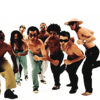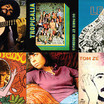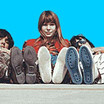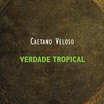Eubioticamente atraídos
the plot of the earth that trembles
Tropicalist verb
THE PLOT OF THE EARTH THAT TREMBLES
The Avant-garde meaning of the bahian group
Hélio Oiticica
Correio da Manhã, October 24, 1968.
The other day I said to a friend: there is something in the air; we breath cultural repression in this country. Those who attempt to creat, in the words of Haroldo de Campos, a “culture of exportation” – the only way to ingest and digest that which bombards us from the outside and throw it back as a valid creation and as our own thing, thereby neutralizing the cultural colonialism to which they wish to permanently subject us – are destined to be undermined, whether by indifference, by the dirtiestnsabotage, or by violent reaction, whether it masquerades as the right, à la coração, or as a certain kind of leftist (orthodox or simply wrong?), tha ends up identifying with this same right through certain activities, principally in the cultural arena. I witnessed this clearly during the debates promoted recently by the Museum of Modern Art in Rio de Janeiro (MAM), in which I ingenuously believed I would find a parallel with avant-garde thought, but I didn’t. Why is it that they wish, or say they wish, to enact structural reform in Brazil, etc. ? And this repression can be seen not only in the extreme positions that I cited above, but also in the liberal ones, the indecisive ones, in those that float nicely through the various social classes, and in the ones that “seriously accept innovations.” And it appears that the argument of “seriouness,” “madness,” etc. is the sweetest weapon with which they defend themselves, even as they promote individual demoralization through gossip, seeking to erode from underneath the integrity of those who really want to “turn the tables”. I wish to call avant-garde thought not that which seeks innovation for innovation’s sake, through gratuitous creativity through the redundancy of the artist reflecting on himself, but that which really wants to turn the tables and all that rests on top. And here, as has already been seen, it will have to be done by violent means given the intellectually impoverished condition in which we find ourselves, the general indifference, the intellectual conformity, the superficiality of positions, and the well-known lack of integrity that pervades our social formation. Repression is suffocating, generalized weak-mindedness. And it is not new: progress has happened through broad hammer strokes, whose echo appears to have been lost in void: the case os Oswald de Andrade is already too well known for it to be cited here; since the inauguration of Concretism and Neo-Concretism, all the attempts that were really innovative seem to have suffered from the same generalized repression: some drop out, others succumb to all kids of sabotage and indifference. Later, what was done “before” is invoked as a lost quality against that which is proposed at the moment, and so forth. It was realIy from the movements of Concretism and Neo Concretism onwards -not from any “isms” limited by spaceand time, but from true sources that provided a newway of”seeing” and “feeling” among us -that things have been taken up again on a grand scale. I won’t sketch this development here, but I want to point out that the permanent “checkmate” to which they have committed themselves, in the visual arena, in language, in the creation of new structures, has prepared the terrain for a realIy universal, profoundly revolutionary critical position in the field of arts, of knowledge, and of behavior. Today we can say that this question of the culture of exportation” (H. Campos) is a reality and is revolutionary, perhaps the most revolutionary of alI. It expresses the consciousness that culture and alI of its products, through a critical-creative method, can demystify alI attempts to impose univeralist cultural colonialism, undeniably an instrument of repression. But “our” culture, is not an isolated plant in a universal desert: in today’s world, that is structuralIy impossible: there is a need for anthropophagy and the very act of”turning the tables” is nothing more than the creation, by isolated or colIective impulses, of this culture.
This consciousness has taken shape today in popular music. What once appeared to be the privilege of artists and poets, filmmakers, and theater directors has gained firm foothold in the field of popular music with the Bahian group ofCaetano, Gil, Torquato, Capinan, and Tom Zé, who alIied themselves with Rogério Duprat, a musician connected to the concrete group ofSão Paulo, and to the band Os Mutantes. Toda the struggle ofthese artists against general repression in Brazil, so welI known to me for the last ten years (repression exercised not only by the dictatorial censorship, but also by the oscillating intelligentsia), takes on an incredible dramatic quality. Here evething has become more dramatic, since it is directly connected to mass consumption, or “mass culture”, etc. and is therefore subject to greater repression. Much has already been written about them (I refer especially to the essays of Augusto de Campos, the densest ones, where he traces their evolutionary lineage). I am here to speak about this in order to clarify certain points that are close y personal interests, in na attempt to establish certain connections between the group and some more universal issues pertaining to avant-garde art. It is first necessary to clarify these issues, so as to counter the mystifications projected on their work by those who are “against” them. Their work has really been subjected to a permanent bombardment, which now appears to have reached a repressive climax never before seen. Since the massacre of Roda Viva, in a São Paulo theater, everything has erupted in an astonishing crescendo, culminating in one of the greatest infamies I have ever witnessed: the booing, the profoundly reactionary, brutal, even physical attacks on Caetano, bis music, Gil, and the Mutantes. This attack doesn’t only target them, but alI of us who create: It is the reaction against that w.hich in a larger context represents “turning the tables,” against that which seeks to peel and rip of the skin of the old structure that Oswald de Andrade dnounced. But contrary to what one would suppose, the reaction took on a certain characteristic, grew, and exploded in a terrible way when confronted with that, which sought to change them. Without a doubt they were Andradian characters. They were students, but reactionary ones despite their applauding Guevara (the symbol of Guevara appears to have been absorbed by the dominant class and become their instrument, in a vague sort of liberalism) and despite belonging to the “Left”. To say they are revolutionaries is one thing, to act like revolutionaries is another one that is much more real, since it’s the way they express themselves. This is not the way it happens every day. They were nothing but the São Paulo bourgeoisie: products of an industrial society in full bloom, full of”well nourished” liberalism, and for that reason, profoundly reactionary. But in my opinion what provoked this reaction is exactly the revolutionary character implicit in the creations and positions of the Bahian group: Caetano and Gil, and their buddies, put their finger on the wound -they are not merely aestheticist revolutionaries, no! Furthermore, today everything that is revolutionary is so in a general, structural fashion, and is never limited only to aestheticism. That is the implicit meaning of what has conventionally beco me known as Tropicalism; not to create another “ism,” or an isolated movement, etc. as used to be the case, but to account for a general cultural condition involving what may even appear to be opposites: José Celso, Glauber, concretists from São Paulo, New Objectivity (an attempt in Rio to bring together artists committed to the avant-garde) etc., as well as the Bahian group, which is primarily responsible for disseminating the idea. Tropicalism became an “ism” that no one can “define,” and this fact neutralizes in a certain way the character of a closed “ism.” The Bahians, always extremely intelligent, fostered the most extensive critique of our popular music, including the attempt to demystify “good taste” as a criteria of judgment in music (there is a parallel there with problems confronted in the arts by Gerchman and myself, at one point, and in theater by José Celso), the reevaluation of this criteria (the repositioning of what is significant in the recent and remote past of popular music), the general absorption of alI types of musical genres from here and abroad, etc. But alI of this was accomplished on a profound structural-level and soon the need emerged, initially within the group, of what I will call an “environmental manifestation”: the need for electric guitars amplifiers, the band, and especially for the costumes, which are not accessories “applied” to a musical structure, but part of a complex language that seeks to create a universal language, where the parts don’t equal the sum as in 1+1=2, but which mutually reconfigure one another. The thing was even further advanced through the illfated presentations of the ridiculous festival (in truth, these festivaIs are like the modero art salons and the bienniaIs: out-dated structures that become ever more academic and which suffocate any kind of innovation), where everything conspired to pulverize them. But the experience took place, and the result could only have been that which occurred in that context, such was the radicalism that drove Caetano, Gil, and Os Mutantes: everything seemed old-fashioned compared to them -there was something like an environmental transubstantiation that was both constructive and cathartic. Caetano’s first presentation reminded me of the court scenes in the film Napoleon by Abel Gance, in which the filmmaker visually distorts the screen, transforming the tribunal into a stormy sea, with the movement of the sea virtual1y transposed. There was something both heroic and pioneering there. As always, they labeled it alI “madness,” which is a profoundly reactionary argument. The song “É Proibido Proibir” (“It’s Forbidden to Forbid) is without a shadow of a doubt one of the most important experiments of Caetano, the logical and legitimate continuation of the day to day becomes more fascinating. Already in “Enquanto Seu Lobo Não Vem” (While Mr. Wolf is Away) and “Mamãe Coragem” (Mother Courage) and an earlier compositional structure, which he himself referred to as a “collage”, the music dissolves into another structure that I would call “open:” the sui generis rhythm forms a counterpoint, word for word, sentence for sentence, to that which isn’t expressed as a priori concepts; even when he says “it is forbidden to forbid,” “I say no to no,” etc., it doesn’t “mean anything,” but is open to many meanings. Already sung, for example, bya collective group, these meanings are offered in as ambivalent way as the original phrases, “no to no,” “forbidden to forbid,” double negative that is an affirmative. Caetano plays with the affirmative contradiction, but plays with it in an way that is also musicalIy open-ended (it is impossible to separate lyrics from music in alI of these experiments), not wishing to “indoctrinate,” but rather to provide semantic elements open to the imagination in a dry, synthetic, and fascinating way. It would be like the slogans of protest marches: “ca-Ia-bou-ço,” (translator’s note: the name of a restaurant where a student protester was killed by military police in March 1968) that through repetition are incorporated rhythmically into successive meanings, into collective and individual life experience so I remember that during the “March of the 100 Thousand,” my friends and I kept thinking about the music and lyrics of”Enquanto seu lobo não vem”: “Let’s take a walk in the hidden forest, my love, let’s walk on the avenue, let’s take the high road.” There were some who even thought that the song was a presage of the march. Perhaps, who knows […] but what happens is that Caetano constructs structures that are increasingly open to the imagination, and therefore, to ever more synthesized participation. Perception is a totality treated as such, and therefore these experiences become comparable to that which is happening in alI fields of the international avant-gardeo The arts used to be separated but tend not to be anymore. There is something like a general poetic globalization: poetry, art, theater, film, music are increasingly without any borders between them. These experiences tend towards this direction, which makes them incomprehensible to our unsophisticated local criticso I remember when, some years ago, Lygia Clark, began with her bichos, which caused widespread indignation, and she needed to make a tremendous effort to “explain” what she was doing. Caetano, misunderstood as he is, smeared from alI directions, is constructing a body of work built day by day through his creative force, his unequaled imagination, through his seriousness and pioneering effort in the impoverished and annoying terrain that is ours. In this festival presentation, everything worked together as a complex whole, full of subjective implications, as always in Caetano: the beautiful arrangement of Duprat, Os Mutantes, the North American, who in my opinion is merely another instrument (how could one have thought to remove him? Only an incompetent organization could have come up with such an idea), Caetano’s clothes would be the visual synthesis of what was shown in the general scene. It was one of the most ambitious attempts of the Bahian group, not because there were “accessories” superimposed on the song, but because what some ignorant people considered accessories” were in fact an “intrinsic” element of the piece; nothing is gratuitous or an “effect.” On the other hand, the charming Dixie band used by the talented Maranhão in his song is, in fact, a gratuitous effect; in this case the composer had the brilliant idea of”dressing up” his piece with the band, which was charming and really quite beautiful, but without any kind of structural transformation: it was just another song, like so many others by the composer or featured in the festival, merely well dressed, although still “well behaved.” That is the profound difference, dearest criticoids, that you didn’t see: Caetano, Gil, Os Mutantes, Duprat, Tom Zé modified structures, created new structures. Their experience is based on longterm modification and cannot be reduced to presentations where the singer arrives, performs; and goes home to sleep in peace after a few glasses of whiskey. Even more misunderstood was Gil, since bis song, which was disqualified by the jury, was in my opinion an extremely important element in bis evolution: “Question of Order” can be reduced, through impressive severity, to sounds, screeches, noises. The singer’s voice and the band which accompanied him (Os Bichos) become pure music and the words seemed to “float” in the general structure. Gil seems to sing and compose with bis whole body, bis throat is amazing, using strong vocaIs similar to the incisive and direct style of northeastern singers, without half tones: his presentation was a moment of glory, reserved and without apparent heroism. He was sure of what he was doing while the fascistic jeering devoured him. Gil’s work merits, urgently, a detailed, profund study (Hello! Hello! De Campos brothers), since it accomplishes a synesthesis of practically all the universal rhytms, as though it were ripping them out by the root from their origins, from the bottom of the sounds, the earth, from the sweat of rites.
In my opinion hisqualification happened because of this stupid pointcounting system for music and lyrics; a super-academic criteria that is no longer useful even for traditional music, much less for experiments of this caliber. Gil’s experiment, although expect ambitious things in musical terms. His music is free and profoundly innovative, capable of taking a composer into a totelly new domain, which justifies the road that he has been significently traveling. The nostalgic will eternally mourn the Gil of “Louvação”, who was indeed great, but who had the courage to break with everything and developed his work in the direction of the unknown, towards that which no “well-behaved” artistis would dare. He takes risks and I know he will succeed. And don’t talk to me of “bluffing”, because I know that Gil was never as precise, as vehement, as right-on about what he wants as he is right now: now yes, those that really understand what these artists want must define themselves: to disqualify “Questão de Ordem” demonstrates profound ignorante, total incapacity of judgment, and reveals the academic structure of this festival. I wonder how they would use this criteria (remember, criteria are universal! Or not??) to judge in this festival certain jazzy pieces or even certain blues songs in which the voice of the singer doesn’t emit a single word for example, “Pinkf,” sung by Sarah Vaughn. How would the jury give marks for music and lyrics? Is it possible that no one sees that this cri teria is the most academic possible, as appalling as the ones they use for the arts, like the dialectical separation between form and content? And they even claim that the festival is class A. Only if it is in terms of stupidity -yes, stupidity really, for there can be no other explanation.
And the Mutantes (what marvelous work!), and Tom Zé, alI but ignored, and Jorge Ben?? They are miles above the rest, that’s the truth. It’s urgent and necessary for the group to construct an experimental theater, or simplyan enclosed space where they could realize experiments with the public, as it is dane throughout the world, especially the interior group experientes “with oneself,” a dig in as Bob Dylan would say, according to what Luís Carlos Saldanha tells me. It is almost suicidal to seek to crush that which is already rotten since much of what can be communicated is lost in this process.
The solution that is even more effective is this kind of collective organization, so that, even if perpetually exposed to sabotage, they will still be able to maintain their own character, and will have greater strength than isolated acts of heroism. As José Celso tells me, to make theater in Brazil today is to riskone’s life, heroically, on a daily basis. And in the arts? I believe that ifI were to conduct today in public the experiments I have been performing, I would be lynched. That is why it is necessary to work in groups, which I call “germinating communities” that are in a certain way segregated “inside of” society (inside and not outside, in the hope of better days), ready to “turn the tables” at any casto The Bahian group has proposed and developed one of the most important revolutions precisely because it is connected to “mass culture” (about whose nature there are more serious problems to be discussed), including extremely interesting experiments with television, which is more difficult, almost impossible, but which was accomplished, if only a single time, on the program Tropicália, or panis et circenses [sic], recorded on tape in a São Paulo cabaret. There, the entire environmental character can be explicit, the “environmental heat” emerges as a totalizingc element In my opinion, it already went beyond a simple organized happening. The structure was more open and there was a greater dose of the imponderable that relates to an experiment that we conducted two months ago on the Aterro of Rio de Janeiro: “Apocalipopótese” (a term invented by Rogério Duarte in order to designate a ‘Certain type of experience related to the concept, algo of his invention, of the “probject” in which the “finished work” doesn’t exist as such but rather as open structures or purely “germinating structures,” in which individual participation is the very creation, whether it is immediate or takes place in the imagination which creates and modifies it). Mário pedrosa, arriving from Europe and becoming aware of “Apocalipopótese,” suggested to me the difference that I already suspected existed and promised to develop something about this soon (I’m going to follow up on your promise, Mario!). In my opinion, the experiment with the TV program, which involves a long story and ended up coming out differently and much less ambitious in relation to what was originally proposed, is important nevertheless for at least showing what can be dane by the Bahian group in the near future. The very existence of an ertvironmental context in which the action occurs (the cabaret and the live filming) and the fact that this action was “filmed” and later “brough to TV”, already involves a series of “transformative categories” – every facet-phase of the process is revealed, given over to perception the local action is recorded and then broadcast on TV, etc. There, the totally cannot be reduced to an isolated happening, to something that occures as if it were a poly-dimensional piece – it was, rather, a totality that existed and exists in the sense that it is “lived” in its multiple dimensions, or lived dimensions – in itself, in the film, in the TV transmission, and in as many others as are possible, such as the possible, such as the poeticized relations of each individual experience there generated, like an infinitesimal cosmos: open structures transformable through participation. The disparaging arguments against this type of experiment, or rather, those that label it “propositional madness” reactionary, consumerist; the identification of all creative endeavors with advertising dominant culture, etc. soon sound false if we examine the origin of the evolution of the process as it developed in tendencies that I call avant-garde. The use of elements connected to mass culture, such as advertising exists, but they are used as a unique conduit for global communication to express “open creative processes,” where experimental exercises are sought in a field where these exercises are strange or appear to be accidental, without predetermined intention. The absence of a rigid ideology, far from being something reactionary, or a form of liberalism, is more connected to an anarchic process that seeks to disintegrate certain structures or annul what has become conventionalized as “beautiful” or “good taste,” “moral,” the “finished product” of arts, etc. The argument of describing this as madness is indeed reactionary because there is no such thing as madness for those who create. As I said once, madness is the conformism of “not experimenting,” an experience which is dead, because it is not carried out to its conclusion, but castrated a priori, for whatever repressive reason: ideological, moral, sexual, etc. Breaking down conditionings of alI kinds and the attempt to “not formulate” rigid concepts, directions or programs, allows continuous transformations in the process while avoiding the risk of creating new conditionings, as always happens. The need for na “experimental exercise of freedom” (M. Pedrosa) is permanent today in these avant-gardes, and this is only possible in experiments in which creative participation in open structures is possible, in experiences that propose “creative inventions” and not “solutions,” that avoid becomihg relativized in small acts of freedom, inconsequential within social conformity -an instrument of domination -but are able to affect individual behavior in a profound manner. Caetano dresses as he wishes not because of a premeditated madness in order to make money selling records (and there is nothing wrong with that if ithappens). When he states that he wants to “break the structures” he intends primarily to open himself up to the demands of creative imagination, as an exercise or a ritual. It is a ritual in continuous transformation and by comunicating this it creates the conditions for its dissemination and growth. If l want to be naked, I am; if l want to wear necklaces, plastic clothes, I wear them; it is the same as saying: do it too, or do what you want, as I do. To say that this is a superficial accessory to bis music, something unnecessary imposed by the media on the star system, is purely the bad faith of not wanting to get to the bottom of things and therefore explaining them in a superficial way. It is the musical process that takes Caetano and his group through each stage, to success visual transformation, to environmental creation, to environmntal creation, to the necessity of propagating what they think and want to the four winds -and this is nothing more than the need to create experimental conditions necessary for these very transformations. But alI of that brings them to the central aspect of this experimental attitude, which is acting on people’s behavior directly, not in apure process of desublimating relaxation, but rather in a creative structuring, an invitation to transform and not to submit to conformity. It is like a plot that unfolds and grows step by step: the plot-experience.























